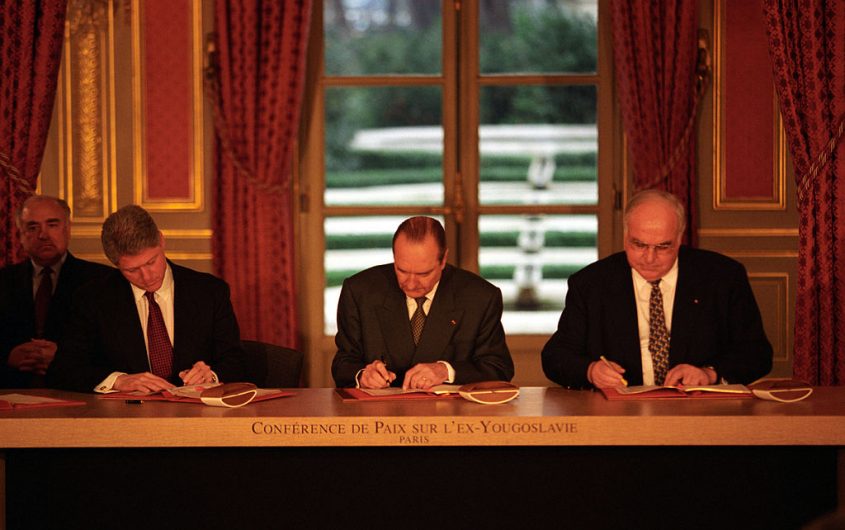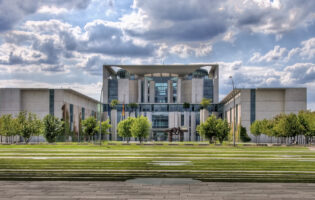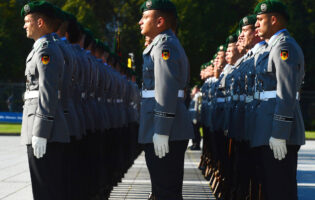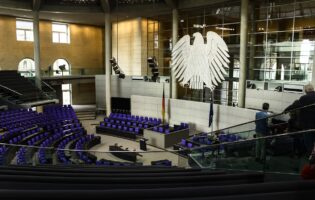
Central Intelligence Agency via Wikimedia Commons
Helmut Kohl and NATO Enlargement: The Search for the Post-Cold War Order

Stephan Kieninger
Historian
Stephan Kieninger is a historian and the author of two books on the history of détente and Euro-Atlantic security: “The Diplomacy of Détente. Cooperative Security Policies from Helmut Schmidt to George Shultz” (London: Routledge, 2018) and “Dynamic Détente. The United States and Europe, 1964–1975” (Lanham: Rowman & Littlefield, 2016). His current research looks into NATO enlargement and the search for the post-Cold War order. He received his Ph.D. from Mannheim University. Formerly, he was a Postdoctoral Fellow at Johns Hopkins SAIS, a Fellow at the Berlin Center for Cold War Studies and a Senior Research Associate at the Federal German Archives.
NATO Enlargement as Order-Building Diplomacy
Helmut Kohl’s achievements as a statesman go well beyond Germany’s unification. In the second half of his sixteen-year tenure, Kohl played a major role in NATO’s enlargement and the emergence of the post-Cold War order.[1] He acted strategically and understood that NATO enlargement had to start with the transformation of NATO’s role against the backdrop of the Clinton administration’s efforts to update and realign the entire architecture of relations between the United States and Europe: “The goal was to put to rest residual problems not just of one war, but of all the European wars and instabilities of the 20th century.”[2]
In March 1993, German defense minister Volker Rühe was the first Western policymaker to advocate NATO enlargement in public. On March 26, 1993, Rühe gave a landmark speech at the International Institute for Strategic Studies in London. He emphasized that “the Atlantic Alliance must not become a ‘closed shop.’ I cannot see one good reason for denying future members of the European Union membership in NATO,” Rühe said.[3] He saw NATO’s opening as a precondition for Europe’s integration. He thought that Europe’s nations were not able to build a common market without also defending each other. Rühe “felt politically and morally obliged to stand up for the unity of Europe, to ensure that those countries that had enabled us all to overcome the division of Europe and the division of Germany enjoyed the same sense of security that we did, and to help prepare the path for them to be integrated into Western structures.”[4] Rühe had not consulted Kohl beforehand. He knew Kohl was more cautious. Kohl only advocated NATO enlargement over time. In September 1993, Kohl argued that, for the time being, “NATO can exclude taking in countries of Eastern Europe. At the NATO Summit [in January 1994], we must talk of restructuring and reorienting NATO. We must tell these Eastern European countries that they can count on our support, but not membership.”[5]
NATO enlargement had to start with the transformation of NATO’s role against the backdrop of the Clinton administration’s efforts to update and realign the entire architecture of relations between the United States and Europe.
Kohl thought along the lines of Bill Clinton’s top Russia adviser Strobe Talbott, believing that a swift enlargement of NATO would antagonize Russia. Kohl’s approach was to kick the contentious issue of NATO enlargement down the road at a time when the West was in the endgame of trying to get the Russian troops out of Germany, Poland, and the Baltic countries and at a point when the United States and Russia were engaged in the dismantlement of nuclear weapons and their associated infrastructure in former Soviet Union states. Kohl’s position only changed with the emergence of NATO’s partnership for peace (PfP) approach in October 1993. PfP was open to the neutral and nonaligned nations as well as the nations of Central and Eastern Europe, including Russia and Ukraine. It avoided the creation of new front lines in Europe and squared a number of “three seemingly competing objectives” as Madeleine Albright noted: “to revitalize NATO, to avoid antagonizing Russia by feeding nationalist tendencies, and to calm growing fears in Central and Eastern Europe.”[6]
The PfP had yet another advantage: It combined a parallelism between containment and engagement in NATO’s approach toward Russia. In January 1994, Secretary of State Warren Christopher and Strobe Talbott argued that “one of the best things about PfP was that it could go in either direction: it could lean forward to accept Russia if the ‘good bear’ emerges, but could also lead to a post-Cold War variant of containment to confront a post-Cold War variant of Russian expansionism.”[7] Thus, NATO enlargement was a hedge and an insurance policy against the return of a more aggressive Russian foreign policy and the further rise of nationalism in the country. The results of the December 1993 Duma elections signaled that Russia might rapidly turn into a bad bear again. The pro-reform party supporting President Boris Yeltsin, Russia’s Choice, received only 15 percent of the vote while the ultra-nationalist “Liberal Democratic Party of Russia” under Vladimir Zhirinovsky’s leadership emerged as the winner with 22.9 percent of the popular vote. The result spurred the willingness of those former Warsaw Pact states that wanted to join NATO. In January 1994, Bill Clinton reassured Vaclav Havel and Lech Walesa that it was no longer a question of whether NATO would enlarge, but how and when. “If historical trends reassert themselves,” Clinton said, “we will have organized ourselves so that we could move quickly not only to NATO membership but other security relations that can serve as a deterrent.”[8]
NATO enlargement was a hedge and an insurance policy against the return of a more aggressive Russian foreign policy and the further rise of nationalism in the country.
Helmut Kohl shared this position. He emphasized that united Germany could not remain forever Europe’s eastern border state on the dividing line between stability and instability. NATO enlargement promised to free Germany from its precarious frontline position. NATO enlargement promised to keep the United States engaged as a European power while giving the Federal Republic stability on its eastern borders and reinsurance against a volatile Russia. The larger NATO projected stability beyond its immediate borders as one central pillar of a new Euro-Atlantic community. Moreover, Helmut Kohl saw NATO enlargement as a moral issue: “We can’t tell the Poles and the Czechs that they are not welcome after what they did to survive communism,” Kohl thought. Last but not least, Kohl believed that security was a precondition for the economic transformation in the states of Central and Eastern Europe: “Europeans cannot build a common market without also defending each other as well. That means that entry into the EU is not a substitute for membership in NATO.”[9]
Helmut Kohl, Bill Clinton, and Russia: NATO Enlargement and Cooperative Security Policy with Boris Yeltsin
Clinton and Kohl saw their endorsement of Yeltsin as an essential investment in Russia’s democratic transition and its integration into the global community. In 1993, Kohl emphasized that “if we do not assist Yeltsin then he has no chance. If we do assist him, he has a chance, but his survival is not certain. If he is toppled then things will be much worse and more expensive for the West, which would have to re-arm.”[10] To be sure, Boris Yeltsin was not a perfect democrat. After seven decades of communist rules, he had to cope with strong forces whose main aim was to roll back democracy and hard-won civil liberties. The results of the December 1993 Duma elections signaled that Russia might rapidly turn away from Yeltsin’s policy of good relations with the West. The enormous gains for the nationalists in Russia troubled Bill Clinton and Helmut Kohl. Both were concerned that a rise of nationalism in Russia would weaken and even destroy Ukraine. Kohl emphasized that he had told Yeltsin that “even any suspicion that Russia wanted to annex Ukraine would be catastrophic.” Clinton agreed, saying that “if Ukraine collapses, because of Russian influence or because of militant nationalists within Ukraine or any other reason, it would undermine the whole theory of NATO’s partnership for peace. Ukraine is the linchpin of the whole idea.”[11]
In addition, starting in December 1994, Moscow’s ensuing war in Chechnya conveyed the message that the country might relapse into authoritarianism at home and expansionism abroad. Beyond the bloodshed in Chechnya, NATO was concerned that the use of force as a means to resolve the dispute might provoke a general emergency in Russia and a potential return to a police state.[12] Russia behaved as a malignant bear. The war fueled fears that NATO membership and the protection by America’s nuclear umbrella were the only ways for Central and East European states to keep Russian troops from reoccupying their countries in a post-Yeltsin era. NATO’s partnership policy toward Russia combined containment and engagement.. Helmut Kohl emphasized that “I am absolutely sure that any possible successor to Boris Yeltsin will be immeasurably more difficult for us. I would like to make the best possible use of the time while he is in office.”[13]
Helmut Kohl was determined to use the window of opportunity as long as Boris Yeltsin was in power. 1997 was a decisive year. Clinton’s and Kohl’s work helped forge a transatlantic consensus on NATO enlargement at NATO’s Madrid summit in July 1997: Poland, the Czech Republic, and Hungary were invited to join NATO—and NATO’s door remained open. French president Jacques Chirac resented Washington’s leadership role in NATO. Bill Clinton was forever grateful for Helmut Kohl’s support. In a meeting with German president Roman Herzog in Washington in July 1997, Clinton praised Kohl in bold terms saying that “the way that Chancellor Kohl handled it at the [Madrid] meeting was the decisive thing in bringing us to a common position. […] In the years since I have been President, the relationship between the United States and Germany has been absolutely fundamental to our ability to achieve our common objectives,” Clinton said. “This is especially the case in the way we supported democracy in Russia, efforts to get the Russian troops out of Baltic states, arms control agreements and many other things. Our partnership was crucial to the success that we have achieved in Bosnia. Chancellor Kohl has helped me worked through my relations with France and other West European countries.”[14]
In addition, in May 1997, NATO and Russia concluded the Founding Act on Mutual Relations, Cooperation and Security. It did not bring Russia into the alliance, but set a road map for future NATO-Russia cooperation. NATO’s overall objective was the emergence of an integrated and undivided Europe including a democratic Russia. “On our side we are going to make it a cornerstone of our approach that we are not talking just about enlargement—we’re discussing a larger issue […] European security as a whole, and Russia is a central element in that,”[15] Deputy Secretary of State Strobe Talbott emphasized in a conversation with Russia’s foreign minister Yevgeniy Primakov. NATO was keen to avoid antagonizing Russia. The alliance pursued a careful military approach to the military enlargement process as a signal that its policy was not aimed at Russia’s military encirclement. In 1997, the NATO allies declared that they had no intention, no plan, and no reason to deploy nuclear weapons on the territory of new members.[16]
NATO’s overall objective was the emergence of an integrated and undivided Europe including a democratic Russia.
And yet, Russia did not interpret these developments as an invitation for integration, but primarily as an assault on Russia’s status and its influence in Europe. To a large extent, Russia’s security policy continued to be based on the traditional concept of a hostile international environment and the assumption that the country needed a sphere of domination over its neighbors for its security. Russian policymakers struggled to conceive NATO enlargement as a win-win premise. The fundamental problem of all NATO-Russia bodies could not be overcome: Russia was at the table and could co-decide, but could not veto on key issues. Boris Yeltsin saw the signing of the NATO-Russia Founding Act in 1997 merely as a damage-limiting exercise: In March 1997, Yeltsin told Clinton that “our position has not changed. It remains a mistake for NATO to move eastward. But I need to take steps to alleviate the negative consequences of this for Russia. I am prepared to enter into an agreement with NATO not because I want to but because it is a forced step. There is no other solution for today.”[17]
When Putin annexed eastern Ukraine and Crimea in 2014, he emphasized the humiliation Russia had suffered in the face of broken promises by the West, including the alleged promise not to enlarge NATO beyond the borders of a reunited Germany.[18] For more than twenty years the narrative of the “broken promise” has been a trademark of Russia’s post-Soviet identity.[19] There is no truth to Putin’s claims.[20] This article underlines that NATO’s cooperative security policy was aimed at bridging the gap between NATO and Russia. NATO’s aim was to build confidence trying to integrate Russia in a Europe whole and free. This was the essence of Helmut Kohl’s statecraft.
[1] See Helmut Kohl, Erinnerungen 1990–1994 (Munich: Droemer & Knauer, 2007); Hans-Peter Schwarz, Helmut Kohl. Eine politische Biografie (Munich: Deutsche Verlags-Anstalt, 2012).
[2] Daniel S. Hamilton, “Pieces of the Puzzle. NATO and Euro-Atlantic Architecture After the Cold War,” in: Daniel S. Hamilton and Kristina Spohr (Eds), Open Door. NATO and Euro-Atlantic Security after the Cold War (Washington DC: Brookings Institution Press, 2019), 7. See James Goldgeier, Not Whether but When. The U.S. Decision to Enlarge NATO (Washington DC: Brookings Institution Press, 1999); Ronald Asmus, Opening NATO’s Door. How the Alliance remade itself for a new Era (New York: Columbia University Press, 2002); Mary E. Sarotte, “How to Enlarge NATO. The Debate inside the Clinton Administration, 1993–95,” in: International Security 44:1 (Summer 2019), 7–41; James Goldgeier and Joshua R. Itzkowitz Shifrinson, “Legacies of NATO Enlargement. International Relations, Domestic Politics, and Alliance Management,” in: Special Issue of International Politics 57:3 (June 2020).
[3] Volker Rühe, “Shaping Euro‐Atlantic Policies. A Grand Strategy for a New Era,” in: Survival, 35: 2 (Summer 1993), 129–137, here 131. On Rühe’s thinking, see Ulrich Weisser, Sicherheit für ganz Europa. Die Atlantische Allianz in der Bewährung (Stuttgart: Deutsche Verlags Anstalt, 1999).
[4] Volker Rühe, Opening NATO’s Door, in: Hamilton and Spohr, Open Door, 217–233, here 220.
[5] Telegram Holbrooke to Secretary of State 4964 “Meeting with Chancellor Kohl,” September 30, 1993, p. 5.
[6] Memo Albright for the President, the Vice President, the Secretary of State and the National Security Advisor “Subject: PfP and Central and Eastern Europe,” January 26, 1994, p. 48.
[7] Telegram Christopher to Department of State (Secto-10020) “Secretary’s Meeting with Foreign Ministers of Hungary, Poland, Slovakia, and the Czech Republic,” January 16, 1994, in FOIA, State Department Virtual Reading Room, Case: M-2017-11649, Doc No. C06548772, Date: 05/08/2018.
[8] Memcon Clinton and Havel, January 11, 1994, in FOIA, State Department Virtual Reading Room, Case No. M-2017-12033, Doc No. C05266111, Date: 06/04/2018.
[9] Memcon Talbott and Kohl, January 14, 1997, FOIA, State Department Virtual Reading Room, Case No. F-2017-13804.
[10] Memcon Clinton and Kohl, March 26, 1993, p. 17.
[11] Telegram Secretary of State to US Bonn State 037335 “Subject: Memcon of Clinton-Kohl January 31 Lunch,” February 12, 1994, in FOIA, State Department Virtual Reading Room, Case No. M-2017-11506, Doc No. 06553748, Date: 05/15/2018.
[12] See James Goldgeier and Michael McFaul, Power and Purpose. U.S. Policy Toward Russia after the Cold War (Washington DC: Brookings Institution Press, 2003); William Burns, The Back Channel. A Memoir of American Diplomacy and the Case for Its Renewal (New York: Random House, 2019).
[13] Telcon Clinton and Kohl, February 7, 1997, p. 390.
[14] Memcon Clinton and Herzog, July 24, 1997, p. 281, 282.
[15] Memcon Talbott and Primakov, July 16, 1996, FOIA, U.S. Department of State, Case No. M-2017-11926, Doc No. C06570196 Date: 05/30/2018.
[16] See “Founding Act on Mutual Relations, Cooperation and Security between NATO and the Russian Federation,” May 27, 1997.
[17] Memcon Clinton and Yeltsin, March 21, 1997, p. 106.
[18] See “Address by President of the Russian Federation,” March 18, 2014.
[19] See Masha Gessen, The Man Without a Face. The Unlikely Rise of Vladimir Putin (New York: Riverhead, 2012); Angela Stent, Putin’s World. Russia against the West and with the Rest (New York: Twelve, 2019).
[20] See Mark Kramer, “The Myth of a No-NATO-Enlargement Pledge to Russia,” The Washington Quarterly, Vol. 32, No. 2 (Spring 2009), 39–61.









